
Placoderms are vertebrate animals of the class Placodermi, an extinct group of prehistoric fish known from Paleozoic fossils during the Silurian and the Devonian periods. While their endoskeletons are mainly cartilaginous, their head and thorax were covered by articulated armoured plates, and the rest of the body was scaled or naked depending on the species.
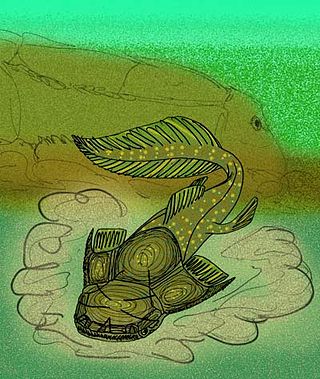
Phyllolepida is an extinct taxon of flattened placoderms found throughout the world, with fossils being found in Devonian strata. Like other flattened placoderms, the phyllolepids were bottom-dwelling predators that ambushed prey. Unlike other flattened placoderms, the phyllolepids were inhabitants of freshwater environments.

Acanthothoraci is an extinct group of chimaera-like placoderms closely related to the rhenanid placoderms. Superficially, the acanthoracids resembled scaly chimaeras and (relatively) heavily armored ptyctodonts. They were distinguished from chimaeras by their large scales and plates, a pair of large spines that emanate from their chests, tooth-like beak plates, and the typical bone-enhanced placoderm eyeball. They were distinguished from other placoderms by differences in skull anatomy and by patterns on the skull plates and thoracic plates that are unique to this order.

Brindabellaspis stensioi is a placoderm with a flat, platypus-like snout from the Early Devonian of the Taemas-Wee Jasper reef in Australia. When it was first discovered in 1980, it was originally regarded as a Weejasperaspid acanthothoracid due to anatomical similarities with the other species found at the reef.

Lunaspis is an extinct genus of armor-plated petalichthyid placoderm fish that lived in shallow marine environments of the Early Devonian period, from approximately 409.1 to 402.5 million year ago. Fossils have been found in Germany, China and Australia. There are three different identified species of within the genus Lunaspis: L. broilii, L. heroldi, and L. prumiensis.

Phyllolepis is the type genus of Phyllolepida, an extinct taxon of arthrodire placoderm fish from the middle to late Devonian. The species of Phyllolepis, themselves, are restricted to the Famennian-aged freshwater strata of the Late Devonian, around 360 million years ago. Fossils of this genus have been found primarily in Europe and North America. The end of the Devonian saw them disappear in a mass extinction.
Gavinaspis is a phyllolepid placoderm which lived during the Early Devonian period, of Qujing, Yunnan province, south China.

Austrophyllolepis is an extinct genus of phyllolepid arthrodire placoderm from Middle to Late Devonian freshwater strata of Australia. The type species, A. ritchiei is found in Givetian to early Frasnian-aged freshwater strata near what is now Mount Howitt. A second species, A. dulciensis, is found from Middle Devonian freshwater strata from the Dulcie Sandstone of Georgina Basin, Central Australia.
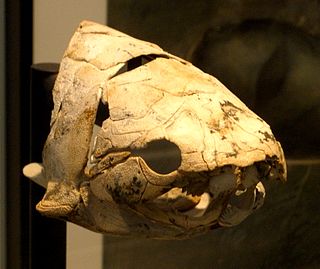
Eastmanosteus is a fossil genus of dunkleosteid placoderms. It was closely related to the giant Dunkleosteus, but differed from that genus in size, in possessing a distinctive tuberculated bone ornament, a differently shaped nuchal plate and a more zig-zagging course of the sutures of the skull roof.

Phyllolepididae is one of two families of phyllolepid placoderms. The family, as a whole, is believed to be descended from the Chinese placoderm, Gavinaspis (which forms the other, monotypic family, "Gavinaspididae"). All but two genera are, more or less, restricted to freshwater habitats of the Early to Middle Devonian of Australia. By the Frasnian, the genus Placolepis would spread throughout the world, with fossils being found in Australia, Turkey, Venezuela, and Antarctica, and by the start of the Famennian, phyllolepids would become extinct in Australia, with only species of Phyllolepis surviving in freshwater environments of Europe and North America.
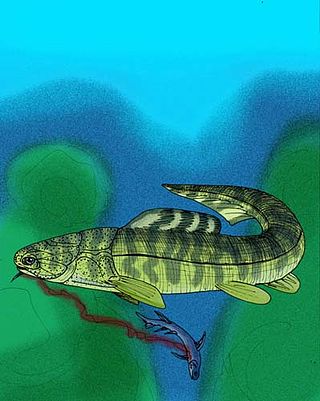
Buchanosteus is an extinct genus of arthrodire placoderm. Its fossils have been found in Early Devonian-aged marine strata throughout Asia and Australia. It contains the following species:
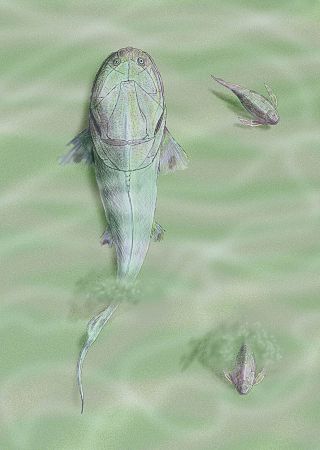
Homostiidae is a family of flattened arthrodire placoderms from the Early to Middle Devonian. Fossils appear in various strata in Europe, Russia, Morocco, Australia, Canada and Greenland.

Buchanosteidae is a family of arthrodire placoderms that lived from the Early to Middle Devonian. Fossils appear in various strata in Russia, Central Asia, Australia, and China.

Errolosteus goodradigbeensis is an extinct buchanosteid arthrodire placoderm. Its fossils have been found in Emsian-aged marine strata of New South Wales, Australia.

Parabuchanosteus murrumbidgeensis is an extinct buchanosteid arthrodire placoderm. Its fossils have been found in the Late Emsian-aged marine strata of New South Wales, Australia.

Taemasosteus is an extinct genus of arthrodire placoderm. Its fossils have been found in Emsian-aged marine strata in New South Wales, Australia. It contains two species, T. novaustrocambricus, and T. maclartiensis.

Goodradigbeeon is an extinct genus of buchanosteid arthrodire placoderm. Its fossils have been found in Emsian-aged marine strata from the Taemas-Wee Jasper reef of New South Wales, Australia and the type species is G. australianum.
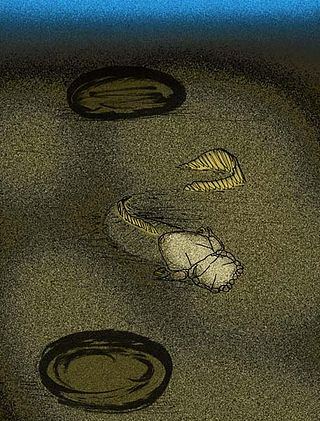
Yurammia is a placoderm from what is now the Pambula River in New South Wales. Unlike all other known phyllolepids, Yurammia's plates had no external grooves.
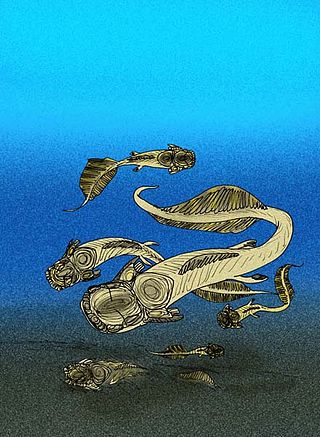
Cowralepis is an extinct genus of phyllolepid placoderm of Givetian Cowra, New South Wales, and several juveniles of various stages of growth have also been discovered. Cowralepis grew to 35 centimeters.
Cobandrahlepis is an extinct genus of phyllolepid placoderm found in New South Wales, Australia.























